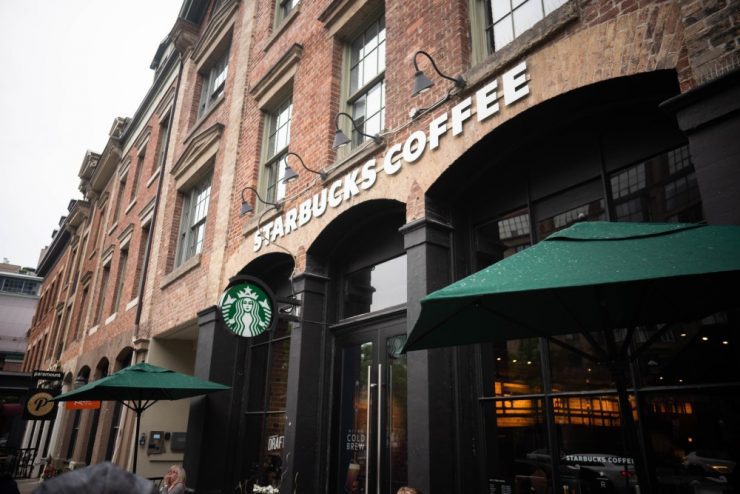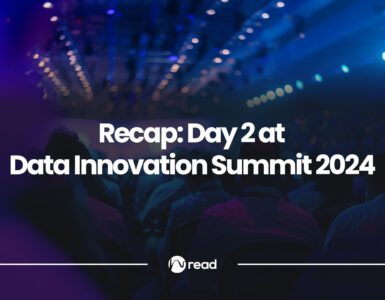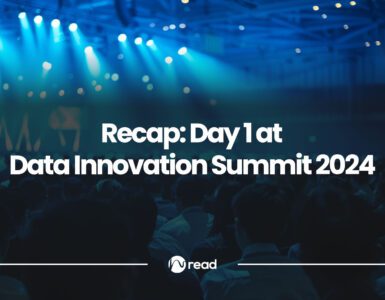If you’ve ever entered a Starbucks store, you’d agree that it’s just like a regular coffee place: espresso shots and latte cups being served, coffee being ground and customers talking to baristas customising their coffee orders. But serving more than 100 million customer occasions across 78 markets around the world, in rapidly changing market conditions, requires the coffee giant to have perfectly orchestrated processes and invest in technological innovations that transform Starbucks from a beverage supplier to a data-driven tech company. Deep Brew is their successful AI-driven platform that drives the brand’s personalisation engine, optimises store labour allocations, and drives inventory management in stores.
But Starbucks’ data transformation started way before the launch of Deep Brew in 2019. So before we zoom in on the coffee giant’s AI-driven platform that helps them serve their data-driven coffee, we’ll explore how they have utilised data in various ways to create value for their business and customers – reinforcing Starbucks as the undisputed coffee shop leader.
Table of contents
- Digital Flywheel: Mobile app for suburb customer experience
- How Starbucks creates value out of data and AI
- Deep Brew: A platform that elevates, humanity, business and customer experience
- The Roadmap of Deep Brew
- Under the hood of Deep Brew
- What does the data-driven future of Starbucks look like?
- Read more related articles
Digital Flywheel: Mobile app for suburb customer experience
Starbucks launched their mobile app in 2011, which marked its point of entry into data and analytics. It turned out to be one of the biggest underpinnings of their digital transformation.
At the beginning, it was intended to be used as a loyalty programme, enabling customers to collect stars for every purchase and redeem them in their next drink order. The app quickly grew into a hub where customers could get information about menus, store locations, and opening hours. Customer activities in the app provided Starbucks with useful insights on the popular store locations, drinks and times of the day.
Today, a quarter of Starbucks’ 100 million weekly transactions happen through its mobile app, and the trend accelerated further with the social distancing measures. What’s more, the app’s members account for nearly 50% of Starbucks’ revenue, reports Yahoo Finance.
As part of their digital flywheel strategy, the Starbucks mobile app allowed coffee lovers to place their orders in advance and collect them through a store window or by walking inside. By merging the power of AI and marketing, the brand has expanded its app features. Now, Starbucks’ digital flywheel consists of four digital components — reward programme, personalisation, payment, and ordering.
No doubt, Starbucks’ digital innovation is credited with driving growth; they have established themselves as experts in creating loyal customers with the help of data.
How Starbucks creates value out of data and AI
Early on, the coffee brand had realised that using data analytics to maximise their customer lifetime value (average purchase price per customer per visit, the number of visits per customer per year, and the average customer lifetime) was going to be the golden ticket for gaining unbeatable competitive advantage.
This how the coffee company used data analytics to maximise customer lifetime value, and at the same time reinvent their brand offerings:
Personalised recommendations
In the first place, collecting and analysing a huge amount of data on customer spending and preferences helped Starbucks personalise the customer experience for every customer based on their unique preferences and spending habits. By analysing the history of orders and patterns, the app can suggest food and beverage choices, but also push tailor-made recommendations according to the time of day and frequency with which the customers usually visit the coffee shop.
By sending real-time triggers and push notifications, Starbucks creates a deeper level of connection with the customers. Buyers notice that the brand takes their preferences into account and delights them with tailoring their experience.
Innovation and new product offerings
Apart from personalisation, Starbucks leverages the data gathered from their digital flywheel to create new products. All their innovative products like non-dairy or unsweetened drinks, summer special drinks, or new home consumption products were the result of analysing users’ preferences and the data behind them.
For example, Starbucks discovered that about 43% of tea drinkers don’t add sugar in their tea and about 25% don’t add milk to their iced coffee when drinking the beverage at home. These insights led to creating two unsweetened ice tea K-Cups — Mango Green Iced Tea and Peachy Black Tea, states TowardsML. Some of the other fruits of their data efforts are pumpkin spice caffe latte and iced coffee without milk or added flavours.
Opening new store locations
You might feel like there’s a Starbucks shop popping up on every corner, but in reality, they carefully use the flywheel data to determine the optimal location for every new Starbucks place. The coffee giant leverages data and AI to make revenue projections based on variables such as income levels, traffic, or competitor presence, and help determine where the next big revenue opportunity is. At the same time, this enables them to minimise the risk of cannibalisation and position the new store in an area that serves a certain customer base.
Deep Brew: A platform that elevates, humanity, business and customer experience
In an interview for Yahoo Finance Live, the former COO of Starbucks, Roz Brewer, stated that the tech-enabled future of the coffee chain is focused on growing drive-thru stores, including customisable menu boards that leverage AI to suggest items based on factors such as the weather, time of day, store inventory, popularity, community preferences and the customer’s purchase history.
Their AI-driven platform Deep Brew allows them to innovate with AI and ML, not only to personalise drive-thru experience but also to automate time-consuming tasks such as inventory management and preventive maintenance on its internet of things (IoT) connected espresso machines.
Usually, when people hear technology and automation being integrated into the workplace, they start to worry that their jobs are being taken over by robots and machines.
However, Kevin Johnson, Starbucks CEO, Gerri Martin-Flickinger, Starbucks chief technology officer and others have a vision they are evangelising that AI is not there to take people’s jobs. Instead, they believe that AI can be used for empowering humanity at the workplace, helping people find ways to lean into their humanity, freeing up time for staff to actively connect with customers and provide that important personal touch.
In Starbucks’ news blog, Martin-Flickinger stated that she believed AI is applicable to virtually every aspect of the business – technology, finance, legal, supply chain, marketing or retail stores.
With their AI technology initiative Deep Brew, they are working on technology that helps amplify the human connection, explained Martin-Flickinger. The broad suite of AI tools is set to elevate every aspect of the business and the in-store and customer experience.
But will that mean that we’ll soon see apron-wearing robots asking for our order at Starbucks? Not at all. Deep Brew is more like an invisible, super-smart sidekick to the human baristas helping do the heavy lifting with inventory, supply chain logistics and replenishment orders, saving partners time, predicting staffing needs and making schedules. It can also help with predictive maintenance, giving staff a heads up before a coffee machine breaks down.
The Roadmap of Deep Brew
The Deep Brew initiative was first launched in 2019 and introduced ML into the coffee company, helping them deploy models into production in their large organisation, said Brian Ames, Lead Manager Data Science, Analytics Ops at Starbucks, during his Data Innovation Summit 2020 talk DeepBrew – Machine Learning at Starbucks – a Roadmap.
The wind in their sale to start with Deep Brew came from strategic initiatives from the competitor McDonald’s acquiring the company Dynamic Yield that was aimed to bring reinforcement learning and machine learning to the fast food place. This event prompted Starbucks C-suite to start looking for a response to this move, and to start thinking about integrating machine learning into their own business. Deep Brew was the perfect response and solution to the fast-moving market changes.
Learn more about the Data Innovation Summit
Deep Brew was especially instrumental in drive-thrus during COVID world last year. With it, they could personalise the recommendations appearing on the screen at different stores with a drive-thru. Every store in every country has its distinctive personality, on top of other factors like the day of the week, time of the day temperature, amount of traffic, etc, explains Brian. These are all points that Starbucks was able to apply in designing their recommendation system driven by Deep Brew.
“Advanced technology, the ability to deploy quickly and some advanced brains is a really nice unlock for Starbucks, affirmed Brian.
Under the hood of Deep Brew
All the things Deep Brew provides are enabled thanks to the amazing data and the foundations Starbucks has – their enterprise data analytics platform EDAP or their data lake unifying the data of different sources, describes Brian. From the lake, they take the data, load it into their Deep Brew platform, run it into a compute layer, and the output reaches and speaks to different touchpoints such as the mobile app, digital drive-thru, website, social media.
Nevertheless, a machine learning system like Deep brew is really challenging to put together because it’s a cross-functional, complex solution. Only a small fraction of the ML system is composed of ML code. For the solution to be successful, all the other components should be navigated too, such as data collection, data verification, feature extraction, process management tools, analysis tools, etc., should be navigated. It can be extremely difficult to unify all other teams and make them understand the importance of having excellence across all the dimensions in order to train the model and get the expected results.
This is why it’s difficult to take a concept from a person’s mind or from research and deploy it at scale in a large organisation, maintains Brian.
Today, their Deep Brew platform is growing nicely and provides highly personalised recommendations to customers. But to reach this stage, Starbucks had to navigate through all the above and learn some hard lessons – or the Seven Deadly Sins to avoid, as Brian calls them.
Some of the pitfalls to avoid while deploying a machine learning system at scale in a large organisation such as Deep Brew Biran shared are:
- Having no meaningful and aligned uplift to the others in the organisation
- Having no baseline to ensure that you do no harm to existing operations
- Not having clear expectations about different jobs impact: is it going to “uplift” or take over their jobs
- No easy access to security guidelines and expertise
- Not taking into account operations
- Having people that are multi-threaded or have conflicting priorities – not having dedicated teams with regular standup meetings
- Telling people that it can’t be done, and not showing for it.
Watch the whole session of Brian Ames at the Data Innovation Summit 2020
What does the data-driven future of Starbucks look like?
As part of their digital flywheel initiative, Deep Brew has brought in a huge success for Starbucks. It has resulted in a spectacular growth in their customer base to nearly 18 million by the end of 2019, leading to same-store sales growth of 6% in the USA.
Apart from the numbers gains, the AI platform has clearly helped the coffee brand achieve their ambition to establish themselves as a data company, and a self-sustaining one for that matter. This means the more data Starbucks collects, the more it can make the right decisions to grow their business.
Boosted by the time-saving AI-driven sidekick, Starbucks staff and partners can dedicate their time to the most important part of the business – coffee and customers. Providing radically personalised, thoughtful product choices gives customers a warm feeling that their preferences matter and massively impact their sentiment towards the beloved coffee brand.
Additionally, operating world-class technology has also awarded the coffee chain with the ability to recruit some of the best talent in technology, stealing away the attention of some candidates who aspired to work at the tech giants.
“Over the next 10 years, we want to be as good at AI as the tech giants,” Starbucks President and CEO Kevin Johnson quoted in Marketing Dive. Starbucks’ strategy is a human-first digital strategy. And this vision is what influences people to want to contribute in an environment that can affect positive change in the world, Johnson adds.
















Add comment